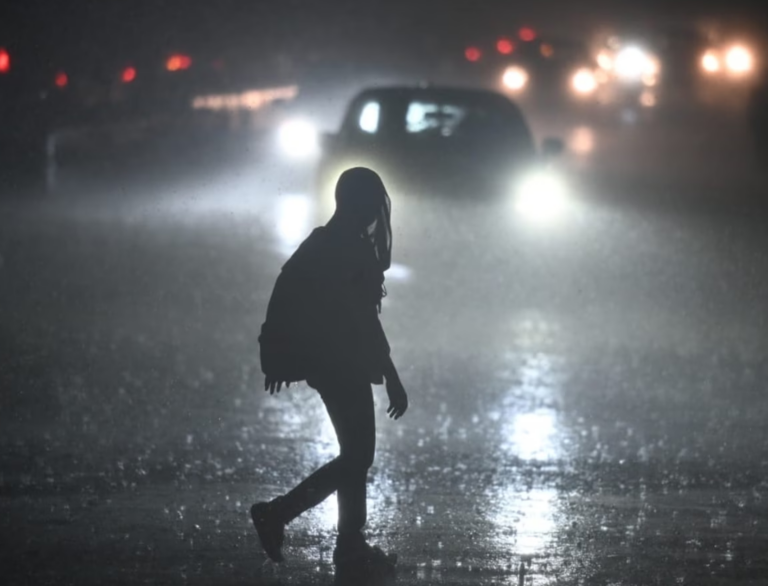
Wednesday evening in Delhi was tumultuous. Most people were stranded due to the heavy downpour. I was among thousands of others who, at one point in time, felt really anxious and clueless about how to get home. Roads had turned into rivers, metro stations became islands, traffic was immovable, and the rain was unforgiving. It wasn’t easy being outside last night, it was daunting, and those trying to make their way home to safety experienced fear.
If I were to speak of last night alone, an India Today piece reports that 10 people died due to the heavy downpour in Delhi-NCR. In Ghazipur, a 22-year-old woman and her toddler drowned as they slipped into a drain due to waterlogging, reports The Hindu. This is the reported story of one night. This year’s first heavy rainfall in Delhi collapsed the roof at the Indira Gandhi International Airport Terminal 1, killing 1 and wounding 8 others. Recently, 3 students in a Delhi IAS coaching centre died after the basement got flooded because of the heavy rabbit.
You see, the reports of bad infrastructure and lack of facilities claiming lives have been around for some time now. Long enough for those in power to take some action, to make it slightly easier for those most affected. Yet, the death toll increases every day.
This is what happens when you live in a dysfunctional city. Fear becomes instinctive. As someone who’s always been allured by city life, being a woman in Delhi isn’t easy. Especially, if you find yourself alone at night with your house hours away, parents anxiously waiting for you, and the city looking like it’s gonna drown.
But I still consider myself far more privileged than most people in the city. I reached home. Even with difficulty, I found an auto, reached the metro, and managed to be home, as late as it was. But as the drowned wheels of my auto-rickshaw slowly tried to pave the way towards the nearest metro station through the heavy traffic, I saw images and sensed a common feeling of helplessness around me.
At a distance, I saw a relatively older woman and a girl, most likely her daughter, rushing somewhere hand-in-hand with their legs half-immersed. I watched a soaked, exhausted old man as he struggled to drag his empty cart, and passersby in their cars yelled at him for being so slow. It was a cruel sight, honestly. Admittedly, traffic can make one feel uneasy, but that man was visibly cold and drenched, and these people were listening to music. A sea of people was simply stranded. They stood underneath the nearest shed, half-intending to wait out the rain. I don’t know how many of them waited and for how long.
With the downpour came helplessness, and it shouldn’t have happened. We’re talking about our National Capital here, after all. Sadly, this is true for many big cities in India. People dream of life in a big city where facilities are top-notch, opportunities are manifold, and living standards are superior. The dream soon disappears when they see the ground reality. Because of the faulty drainage systems, improper maintenance, illegal encroachments, absence of facilities, and those in power not doing their jobs, they are left to battle the waterlogging-induced floods on their own. It is then the big city dream feels more like a hoax.
The problem is people whom we trust and hold responsible for eliminating these problems have different priorities, apparently. Before name-changing the places, their infrastructure needs to change. Before selling the illusion of development, the city, at its core, should feel safe. Women and people from underprivileged communities always become the most affected each time a situation like this occurs. What are they supposed to do, and why is it that it is ‘to each their own’?
When you live in a dysfunctional city, the feeling of safety can be a privilege. When you’re a woman, this situation only worsens because, you know, a woman alone and Delhi at night are old enemies. You’re never completely safe. But it’s on days like last night you question everything.
Why is being safe so uncommon? How are we always so unprepared for the rain? Why aren’t there enough facilities? Who do we trust to solve this? When does it get better? Will a ‘better’ ever exist?
Read More From Women
Radhika Apte’s Raw and Real Maternity Shoot is The Celebration of Motherhood We Needed
Isha Jain
Ananya Panday On Being Called ‘Chicken Legs’ and ‘Flat Chest’ In School & Why We Must Talk About It
Isha Jain
India’s Got Latent Contestant Jokes About Deepika Padukone’s Depression & Here’s Why It’s Not Okay
Isha Jain